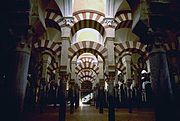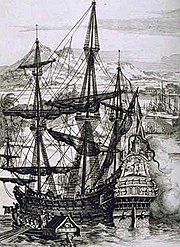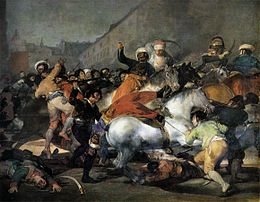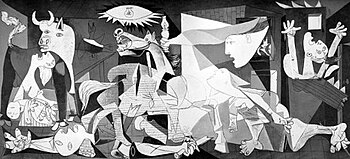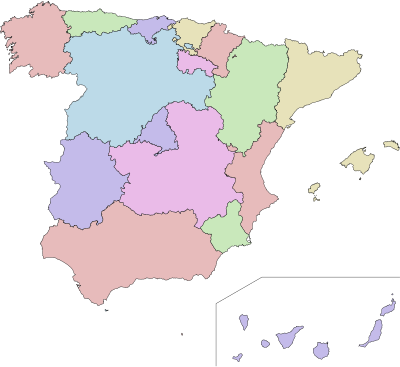

Spain (Spanish: , IPA: [es'paɲa]), officially Kingdom of Spain (Reino de España), [5] is a country located in southwestern Europe on the Iberian Peninsula. The Spanish mainland is bordered to the south and east almost entirely by the Mediterranean Sea (except for a tiny land boundary with Gibraltar); to the north by France, Andorra, and the Bay of Biscay; and to the west by the Atlantic Ocean and Portugal. Spanish territory also includes the Balearic Islands in the Mediterranean, the Canary Islands in the Atlantic Ocean off the African coast, and two autonomous cities in North Africa, Ceuta and Melilla, that border Morocco. With an area of 504,030 km², Spain is the second largest country in Western Europe (behind France) and with an average altitude of 650m, the second highest country in Europe (behind Switzerland).
Spain is a constitutional monarchy organised as a parliamentary democracy, and has been a member of the European Union since 1986. It is a developed country with the ninth largest economy in the world and fifth largest in the EU, based on nominal GDP.[6]
History
Summary
Spain is a key site when it comes to studying both the arrival of the first hominids recorded in Europe, and the prehistoric stage of this continent. Under the Roman Empire, Hispania flourished and became one of the empire's most important regions. During the early Middle Age it came under Germanic rule. Later, nearly the entire peninsula came under Muslim rulers. Through a long process Christian kingdoms in the north gradually rolled back Muslim rule, which was finally extinguished in 1492. That year Columbus reached the Americas, the beginnings of a global empire. Spain became the strongest kingdom in Europe in the 16th and first half of the 17th centuries but continued wars and other problems eventually led to a diminished status. In the middle decades of the 20th century it came under a dictatorship, under which it went through many years of stagnation and then a spectacular economic revival. Democracy was recovered in 1978 under the form of a constitutional monarchy. In 1986 it joined the European Union and has experienced an economic and cultural renaissance.
Prehistory and pre-Roman peoples in the Iberian Peninsula
Archeological research at Atapuerca indicates that the Iberian Peninsula was peopled more than a million years ago.[7] Modern humans in the form of Cro-Magnons began arriving in the Iberian Peninsula through the Pyrenees some 35,000 years ago. The best known artifacts of these prehistoric human settlements are the famous paintings in the Altamira cave of Cantabria in northern Spain, which were created about 15,000 BCE. Furthermore, archeological evidence in places like Los Millares in Almería and in El Argar in Murcia suggests that developed cultures existed in the eastern part of the Iberian Peninsula during the late Neolithic and the Bronze Age.
The two main historical peoples of the peninsula were the Iberians and the Celts, the former inhabiting the Mediterranean side from the northeast to the southwest, the latter inhabiting the Atlantic side, in the north and northwest part of the peninsula. In the inner part of the peninsula, where both groups were in contact, a mixed, distinctive, culture was present, known as Celtiberian. In addition, Basques occupied the western area of the Pyrenees mountains. Other ethnic groups existed along the southern coastal areas of present day Andalusia. Among these southern groups there grew the earliest urban culture in the Iberian Peninsula, that of the semi-mythical southern city of Tartessos (perhaps pre-1100 BC) near the location of present-day Cádiz. The flourishing trade in gold and silver between the people of Tartessos and Phoenicians and Greeks is documented in the history of Strabo and in the biblical book of king Solomon. Between about 500 BC and 300 BC, the seafaring Phoenicians and Greeks founded trading colonies all along the Spanish Mediterranean coast. Carthaginians briefly took control of much of the Mediterranean coast in the course of the Punic Wars, until they were eventually defeated and replaced by the Romans.[8].
Roman Empire and Germanic invasions
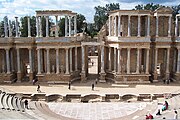
During the Second Punic War, an expanding Roman Empire captured Carthaginian trading colonies along the Mediterranean coast (from roughly 210 BC to 205 BC), leading to eventual Roman control of nearly the entire Iberian Peninsula - a control which lasted over 500 years, bound together by law, language, and the Roman road.[9] The base Celt and Iberian population remained in various stages of Romanisation,[10] and local leaders were admitted into the Roman aristocratic class.[8]
The Romans improved existing cities, such as Lisbon (Olissis bona or 'good for Ulysses') and Tarragona (Tarraco), and established Zaragoza (Caesaraugusta), Mérida (Augusta Emerita), Valencia (Valentia), León ("Legio Septima"), Badajoz ("Pax Augusta"), and Palencia (Παλλαντία, "Pallas Ateneia").[11] The peninsula's economy expanded under Roman tutelage. Hispania served as a granary for the Roman market, and its harbors exported gold, wool, olive oil, and wine. Agricultural production increased with the introduction of irrigation projects, some of which remain in use. Emperors Trajan, Theodosius I, and the philosopher Seneca were born in Hispania.[12] Christianity was introduced into Hispania in the first century CE and it became popular in the cities in the second century CE.[8] Most of Spain's present languages and religion, and the basis of its laws, originate from this period.[9]
The first Germanic tribes to invade Hispania arrived in the 5th century, as the Roman Empire decayed.[9] The Visigoths, Suebi, Vandals and Alans arrived in Spain by crossing the Pyrenees mountain range.[13] The Romanized Visigoths entered Hispania in 415. After the conversion of their monarchy to Roman Catholicism, the Visigothic Kingdom eventually encompassed a great part of the Iberian Peninsula after conquering the disordered Suebic territories in the northwest and Byzantine territories in the southeast.[8]
Muslim Iberia
In the 8th century, nearly all of the Iberian Peninsula was conquered (711-718) by mainly Berber Muslims (see Moors) from North Africa. These conquests were part of the expansion of the Umayyad Islamic Empire.[14] Only a number of areas in the mountains to the north of the Iberian Peninsula managed to cling to their independence, occupying the areas roughly corresponding to modern Asturias, Navarre and Aragon.
Under Islam, Christians and Jews were recognised as "peoples of the book", and were free to practice their religion, but faced a number of mandatory discriminations and penalties as dhimmis.[15][16][17] Conversion to Islam proceeded at a steadily increasing pace. Following the mass conversions in the 10th and 11th centuries it is believed that Muslims came to outnumber Christians in the remaining Muslim controlled areas.[18]
The Muslim community in the Iberian peninsula was itself diverse and beset by social tensions. The Berber people of North Africa, who had provided the bulk of the invading armies, clashed with the Arab leadership from the Middle East.[19] Over time, large Moorish populations became established, especially in the Guadalquivir River valley, the coastal plain of Valencia, and (towards the end of this period) in the mountainous region of Granada.[18]
Córdoba, the capital of the caliphate, was the largest, richest and most sophisticated city of medieval Europe.[20] Mediterranean trade and cultural exchange flourished. Muslims imported a rich intellectual tradition from the Middle East and North Africa. Muslim and Jewish scholars played a great part in reviving and expanding classical Greek learning in Western Europe. The Romanized cultures of the Iberian peninsula interacted with Muslim and Jewish cultures in complex ways, thus giving the region a distinctive culture.[18] Outside the cities, where the vast majority lived, the land ownership system from Roman times remained largely intact as Muslim leaders rarely dispossessed landowners, and the introduction of new crops and techniques led to a remarkable expansion of agriculture.
However, by the 11th century, Muslim holdings had fractured into rival Taifa kingdoms, allowing the small Christian states the opportunity to greatly enlarge their territories and consolidate their positions.[18] The arrival of the North African Muslim ruling sects of the Almoravids and the Almohads restored unity upon Muslim holdings, with a stricter, less tolerant application of Islam, but ultimately, after some successes in invading the north, proved unable to resist the increasing military strength of the Christian states.[8]
Fall of Muslim rule and unification
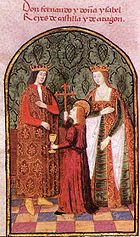
The term Reconquista ("Reconquest") is used to describe the centuries-long period of expansion of Spain's Christian kingdoms; the Reconquista is viewed as beginning after the battle of Covadonga in 722. The Christian army victory over the Muslim forces lead to the creation of the Christian Kingdom of Asturias. Muslim armies had also moved north of the Pyrenees, but they were defeated at the Battle of Poitiers in France. Subsequently, they retreated to more secure positions south of the Pyrenees with a frontier marked by the Ebro and Duero rivers in Spain. As early as 739 Muslim forces were driven from Galicia, which was to host one of medieval Europe's holiest sites, Santiago de Compostela. A little later Frankish forces established Christian counties south of the Pyrenees; these areas were to grow into kingdoms, in the north-east and the western part of the Pyrenees. These territories included Navarre, Aragon and Catalonia.[21]
The breakup of Al-Andalus into the competing Taifa kingdoms helped the expanding Christian kingdoms. The capture of the central city of Toledo in 1085 largely completed the reconquest of the northern half of Spain.[22] After a Muslim resurgence in the 12th century, the great Moorish strongholds in the south fell to Christian Spain in the 13th century—Córdoba in 1236 and Seville in 1248—leaving only the Muslim enclave of Granada as a tributary state in the south.[23] Marinid invasions from north Africa in the 13th and 14th centuries failed to re-establish Muslim rule. Also in the 13th century, the kingdom of Aragon, still ruled by the Catalan count of Barcelona, expanded its reach across the Mediterranean to Sicily.[24]
In 1469, the crowns of the Christian kingdoms of Castile and Aragon were united (even though both kingdoms kept a high degree of political and economical independence) by the marriage of Isabella and Ferdinand. In 1478 began the final stage of the conquest of Canary Islands and in 1492, these united kingdoms captured Granada, ending the last remnant of a 781-year presence of Islamic rule in the Iberian Peninsula.[25] The year 1492 also marked the arrival in the New World of Christopher Columbus, during a voyage funded by Isabella. That same year, Spain's Jews were ordered to convert into the Catholicism or face expulsion from Spanish territories during the Spanish Inquisition.[26][27]
As Renaissance New Monarchs, Isabella and Ferdinand centralized royal power at the expense of local nobility, and the word España - whose root is the ancient name "Hispania" - began to be used to designate the whole of the two kingdoms.[27] With their wide-ranging political, legal, religious and military reforms, Spain emerged as the first world power.
Imperial Spain
The unification of the kingdoms of Aragon, Castile, León, and Navarre laid the basis for modern Spain and the Spanish Empire. Spain became Europe's leading power throughout the 16th century and most of the 17th century, a position later reinforced by trade and wealth from colonial possessions. Spain reached its apogee during the reigns of the first two Spanish Habsburgs, Charles I (1516–1556) and Philip II (1556–1598). Included in this period are the Italian Wars, the Dutch revolt, clashes with the Ottomans, the Anglo-Spanish war and war with France.[28]
The Spanish Empire expanded to include most part of South and Central America, Mexico, southern and western portions of today's United States, the Philippines, Guam and the Mariana Islands in Eastern Asia, the Iberian peninsula (including the Portuguese Empire (from 1580), southern Italy, Sicily, cities in Northern Africa, as well as parts of modern Germany, Belgium, Luxembourg, and the Netherlands. It was the first empire about which it was said that the sun did not set. This was an age of discovery, with daring explorations by sea and by land, the opening up of new trade routes across oceans, conquests and the beginning of European colonial exploitation. Along with the arrival of precious metals, spices, luxuries, and new agricultural plants, Spanish explorers and others brought back knowledge, playing a leading part in transforming the European understanding of the world.[29]
Of note was the cultural efflorescence now known as the Spanish Golden Age and the intellectual movement known as the School of Salamanca.
In the 16th and 17th centuries Spain was confronted by unrelenting challenges from all sides. In the early 16th century Barbary pirates under the aegis of the rapidly growing Ottoman empire, disrupted life in many coastal areas through their slave raids and renewed the threat of an Islamic invasion.[30] This at a time when Spain was often at war with France in Italy and elsewhere. Later the Protestant Reformation schism from the Catholic Church dragged the kingdom ever more into the mire of religiously charged wars. The result was a country forced into ever expanding military efforts across Europe and in the Mediterranean.
The great plague of 1596-1602 killed 600,000 to 700,000 people, or about 10% of the population. Altogether more than 1,250,000 deaths resulted from the extreme incidence of plague in 17th century Spain.[31]
By the middle decades of the war-ridden 17th century the effects of the strain began to show. The Spanish Habsburgs had enmeshed the country in the continent wide religious-political conflicts. These conflicts drained it of resources and undermined the European economy generally. Spain managed to hold on to the majority of the scattered Habsburg empire, and help the Imperial forces of the Holy Roman Empire reverse a large part of the advances made by Protestant forces, but it was finally forced to recognise the independence of Portugal - with its empire - and the Netherlands, and eventually began to surrender territories to France after the immensely destructive, Europe-wide Thirty Years War.[32] From the 1640s Spain went into a gradual but seemingly irreversible decline for the remainder of the century, however it was able to maintain and enlarge its vast overseas empire which remained intact until the 19th century.
Controversy over succession to the throne consumed the first years of the 18th century. The War of Spanish Succession (1701–1714), a wide ranging international conflict combined with a civil war, cost Spain its European possessions and its position as one of the leading powers on the Continent (although it retained its overseas territories).[33]
During this war, a new dynasty—the French Bourbons—was installed. Long united only by the Crown, a true Spanish state was established when the first Bourbon king Philip V of Spain united Castile and Aragon into a single state, abolishing many of the regional privileges (fueros).[34]
The 18th century saw a gradual recovery and some increase in prosperity through much of the empire. The new Bourbon monarchy drew on the French system of modernising the administration and the economy. Enlightenment ideas began to gain ground among some of the kingdom's elite and monarchy. Towards the end of the century trade finally began growing strongly. Military assistance for the rebellious British colonies in the American War of Independence improved Spain's international standing.[35]
Napoleonic rule and its consequences
In 1793, Spain went to war against the new French Republic, which had overthrown and executed its Bourbon king, Louis XVI. The war polarised the country in an apparent reaction against the gallicised elites. Defeated in the field, Spain made peace with France in 1795 and effectively became a client state of that country; the following year, it declared war against Britain and Portugal. A disastrous economic situation, along with other factors, led to the abdication of the Spanish king in favour of Napoleon's brother, Joseph Bonaparte.
This new foreign monarch was regarded with scorn. On May 2, 1808, the people of Madrid began a nationalist uprising against the French army, marking the beginning of what is known to the Spanish as the War of Independence, and to the English as the Peninsular War. Napoleon was forced to intervene personally, defeating several badly-coordinated Spanish armies and forcing a British Army to retreat to Corunna. However, further military action by Spanish guerrillas and Wellington's Anglo-Portuguese army, combined with Napoleon's disastrous invasion of Russia, led to the ousting of the French from Spain in 1814, and the return of King Ferdinand VII.
The French invasion proved disastrous for Spain's economy, and left a deeply divided country that was prone to political instability for more than a century. The power struggles of the early 19th century led to the loss of all of Spain's colonies in Latin America, with the exception of Cuba and Puerto Rico.
Spanish-American War
Amid the instability and economic crisis that afflicted Spain in the 19th century there arose nationalist movements in the Philippines and Cuba. Wars of independence ensued in those colonies and eventually the United States became involved. Despite the commitment and ability shown by some military units, they were so mismanaged by the highest levels of command that the Spanish-American war of 1898 was soon over. "El Desastre" (The Disaster), as the war became known in Spain, helped give impetus to the Generation of 98 who were already conducting much critical analysis concerning the country. It also weakened the stability that had been established during Alfonso XII's reign.
